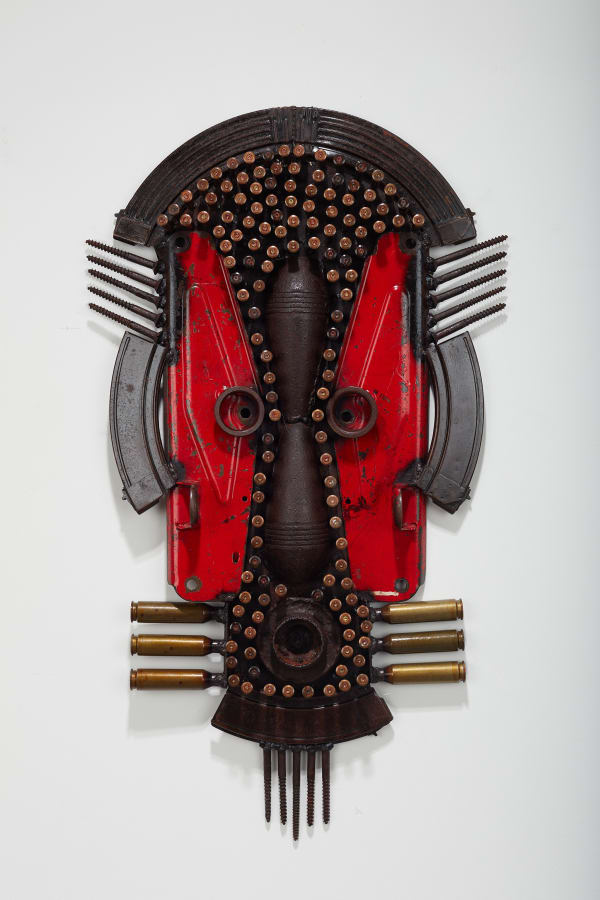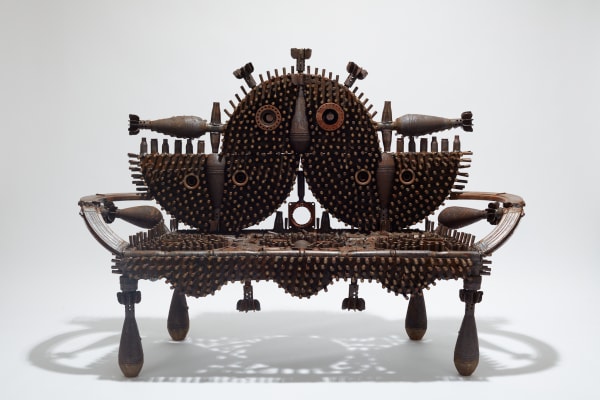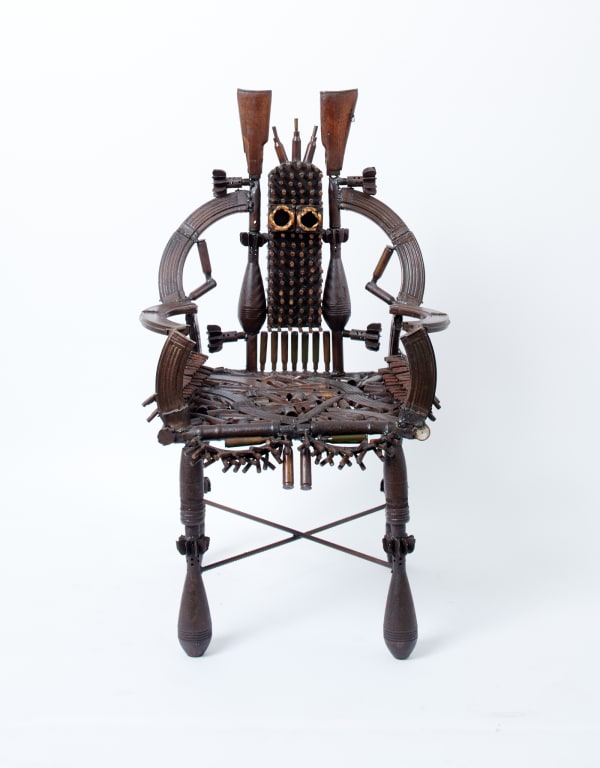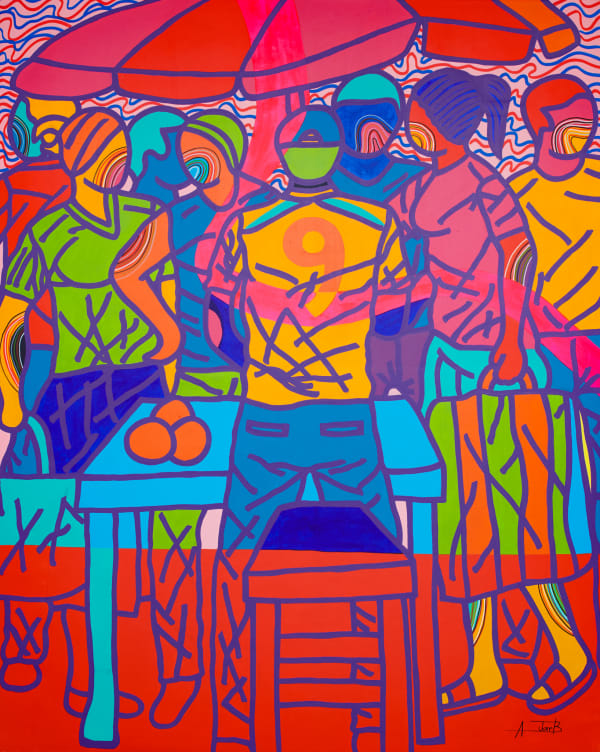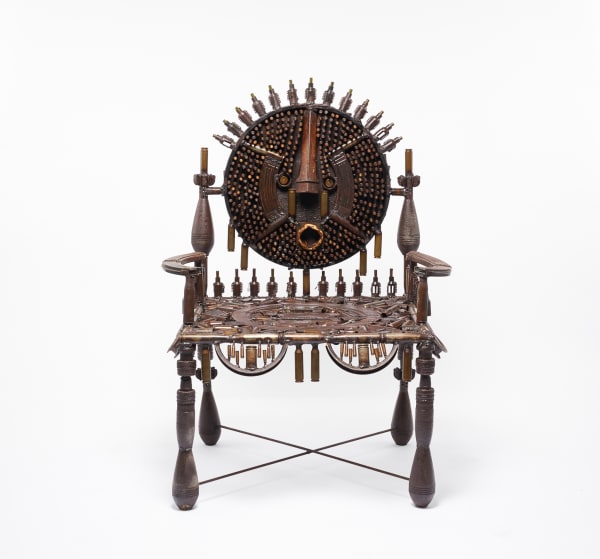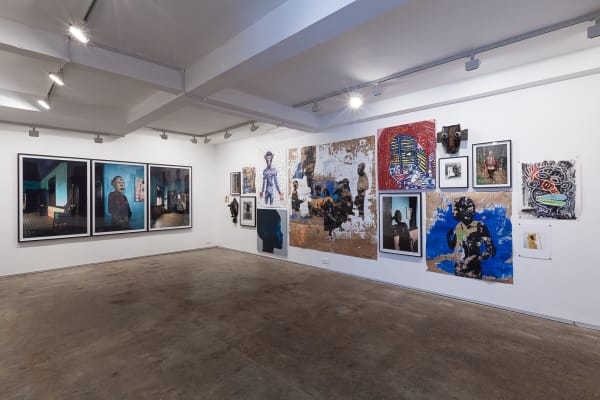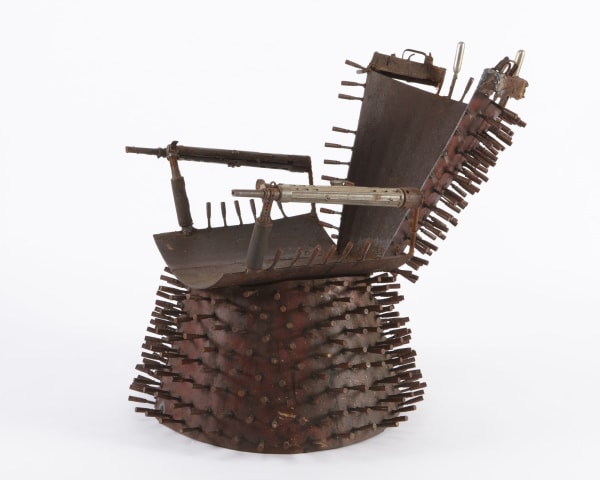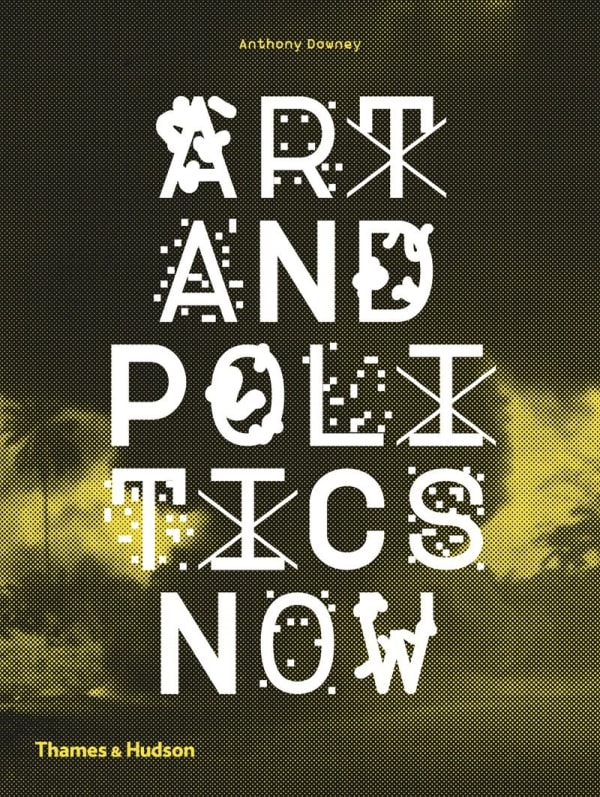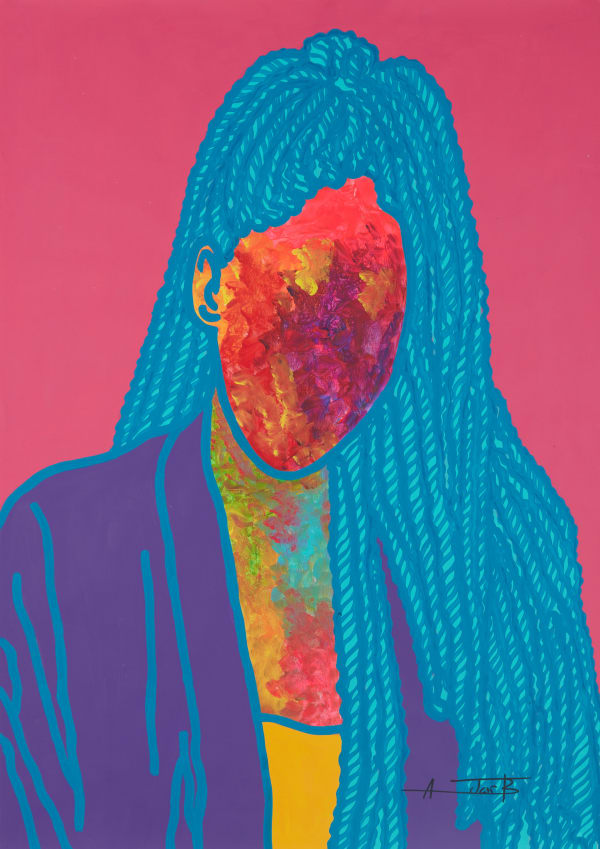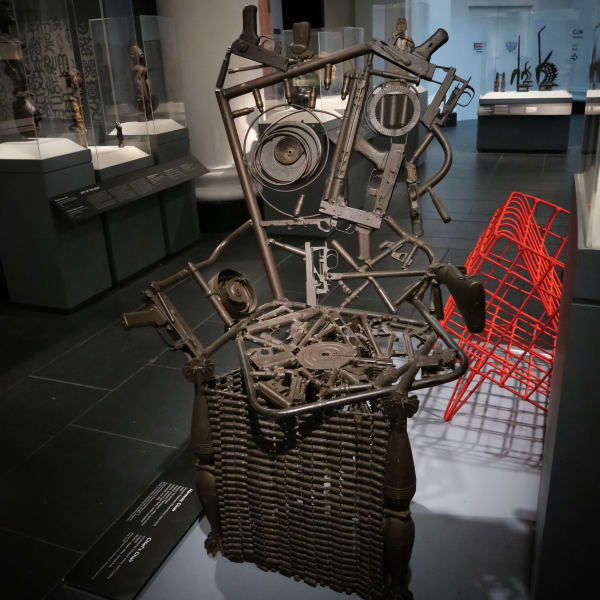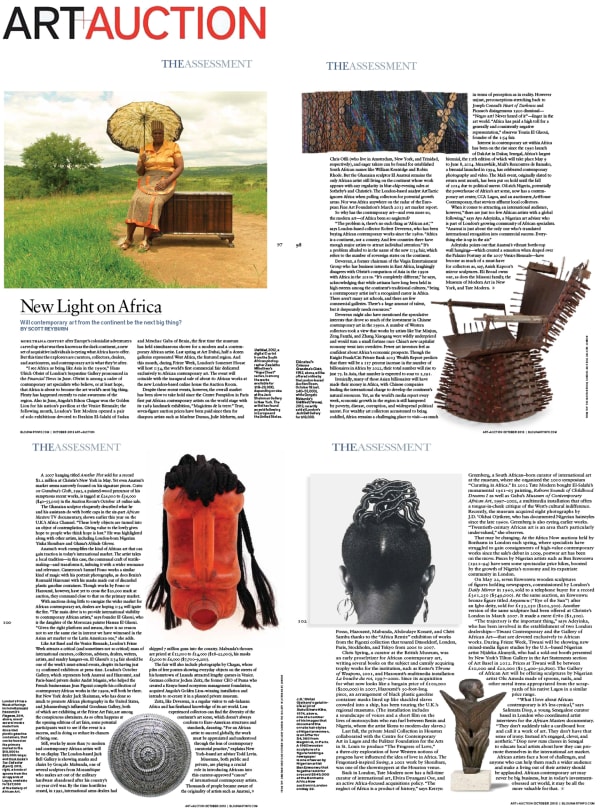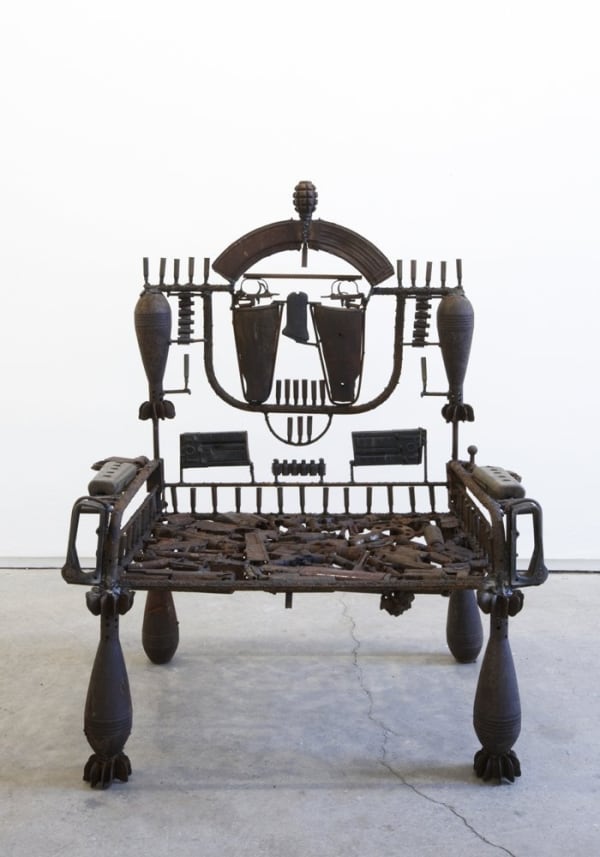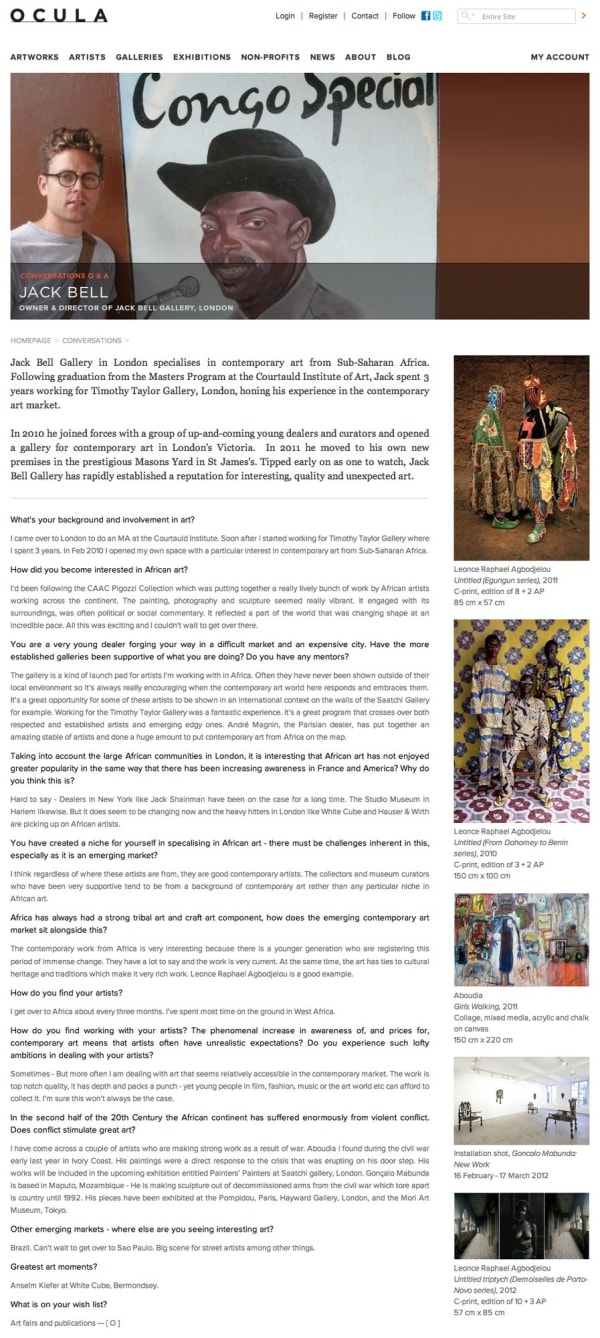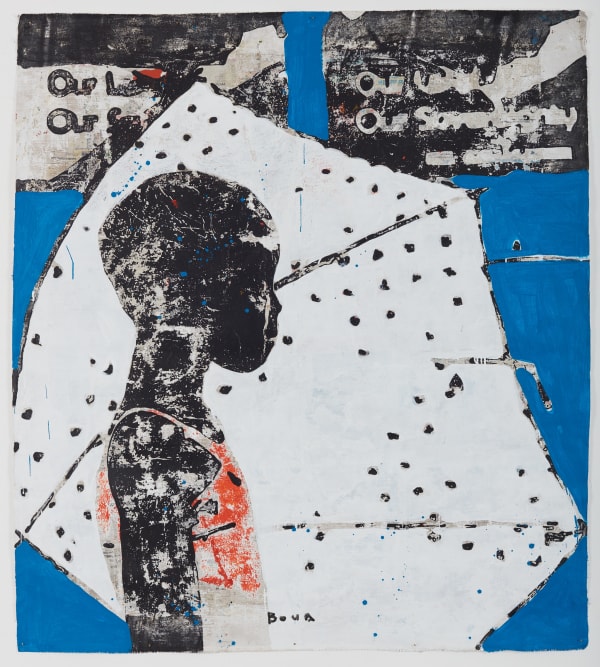Goncalo Mabunda Maputo, Mozambique, b. 1975
Mabunda draws on the collective memory of his country, Mozambique, in particular its long and terrible civil war, working with dismantled arms recovered from the sixteen-year conflict that divided the region.
In his celebrated series of thrones and masks, Mabunda reassembles AK47s, rocket launchers, pistols and other weapons of destruction into symbolic pieces that critique political and military power systems and celebrate the long lineage and influence of traditional, tribal African arts. Denied their original function, the thrones and ceremonial masks are reconfigured, much like the materials from which they are made, into objects that honour the resilience and creativity of African civilian societies and the transformative power of art.
Exhibitions include the Gangwon International Biennale, South Korea, ‘All the World’s Futures’ at the 2015 Venice Biennale, ‘Making Africa’ at the Vitra Museum, Germany, 'Africa Now: Political Patterns' at the Seoul Museum of Art, The Past, The Present and the Inbetween, National Pavilion of Mozambique at the 2019 Venice Biennale, Ex Africa - Présences africaines dans l'art d'aujourd'hui, Musée du Quai Branly, Paris, France, Narrative Wisdom and African Arts at the Saint Louis Art Museum, USA and Reporting House, Balkan Investigative Reporting Network, Pristina, Kosovo among others.
His work has been acquired by Chazen Museum of Art at University of Wisconsin-Madison, Minneapolis Institute of Art, Brooklyn Museum, Centre Pompidou, Paris, Fondation H, Paris, the Vatican Museums, Vatican City and Saint Louis Art Museum.
-

Summer Salon Show
28 Jun - 26 Jul 2024Larkin Durey is delighted to present a survey of the following selected artists that demonstrates the breadth and history of the gallery programme. Aboudia Asad Faulwell Massoud Hayoun Goncalo Mabunda...Read more -

Gonçalo Mabunda
The Chronicler’s Throne 9 Jun - 1 Jul 2022Press preview: Thursday 9 June, 1 - 3 pm Jack Bell Gallery is pleased to present a body of new sculptures by Gonçalo Mabunda. For the artist's ninth solo exhibition...Read more -

Goncalo Mabunda
Night Citizen 29 Mar - 23 Apr 2021Jack Bell Gallery is pleased to present a body of new sculptures by Gonçalo Mabunda. For the artist’s eighth solo exhibition with the gallery, Mabunda draws on the collective memory...Read more -

Goncalo Mabunda
The Negotiator | Online exhibition 13 Jul - 28 Aug 2020Jack Bell Gallery is pleased to present a body of recent sculptures by Gonçalo Mabunda. For the artist’s seventh solo exhibition with the gallery, Mabunda draws on the collective memory...Read more
-

Goncalo Mabunda
Orator of Time 17 - 31 May 2019Private view Thursday 16th May 2019, 6 - 8 pm Jack Bell Gallery is pleased to present a body of new sculptures by Gonçalo Mabunda. For the artist’s sixth solo...Read more -

Rassemblement
Group exhibition 20 Jul - 3 Aug 2018Private view: Thursday 19 July, 6 - 8 pm Aboudia Leonce Raphael Agbodjelou Ajarb Bernard Ategwa Armand Boua Goncalo Mabunda Hamidou Maiga Boris Nzebo Bambo SibiyaRead more -

Goncalo Mabunda
The Messenger 13 - 27 Apr 2018Private view: Thursday 12 April 2018, 6 - 8 pm Jack Bell Gallery is pleased to present a body of new sculptures by Gonçalo Mabunda. For the artist’s fifth solo...Read more -

Devil in Disguise
Group exhibition 11 - 19 Aug 2017Private view: Thursday 10 August 2017 Aboudia Baatarzorig Batjargal Armand Boua Gonçalo Mabunda Lavar Munroe Boris NzeboRead more
-

Goncalo Mabunda
Emperor of the Sands 9 - 22 Jun 2017Private view: Thursday 8 June 2017, 6 - 8 pm Jack Bell Gallery is pleased to present an exhibition of sculpture by contemporary artist Gonçalo Mabunda. For his fourth solo...Read more -

Le Penseur
Group exhibition 5 - 13 Aug 2016Aboudia Leonce Raphael Agbodjelou Armand Boua Karen Hampton Goncalo Mabunda Hamidou Maiga Gastineau Massamba Boris Nzebo Private view: Thursday 4 August 2016, 6 - 8 pmRead more -

Gonçalo Mabunda
Manuscripts 10 - 22 Jun 2016Jack Bell Gallery is pleased to present an exhibition of sculpture by contemporary artist Gonçalo Mabunda. For his third solo show with the gallery, the artist draws on the collective...Read more -

Studio Lumiere
10 Contemporary Artists Living & Working in Africa 19 - 28 Aug 2015Jack Bell Gallery is pleased to present a group show of work by 10 contemporary artists living and working in Africa. Spanning Abidjan to Timbuktu and Douala to Kinshasa, 'Studio...Read more
-

Gonçalo Mabunda
When I Get Green 12 Jul - 10 Aug 2013Contemporary African art in LondonRead more -

Goncalo Mabunda
New Work 16 Feb - 17 Mar 2012Jack Bell Gallery is pleased to present a solo exhibition of new work by Gonçalo Mabunda. Mabunda is interested in the collective memory of his country, Mozambique, which has only...Read more
-

Narrative Wisdom and African Arts
Saint Louis Art Museum Nichole Bridges, 2024 Read more -

10 x 154
Art Africa Limited, 2022 Read more -
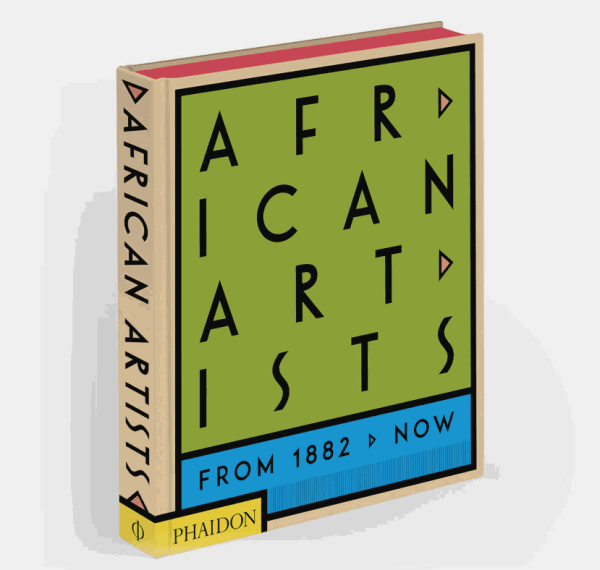
African Artists
Phaidon 2021 Read more -
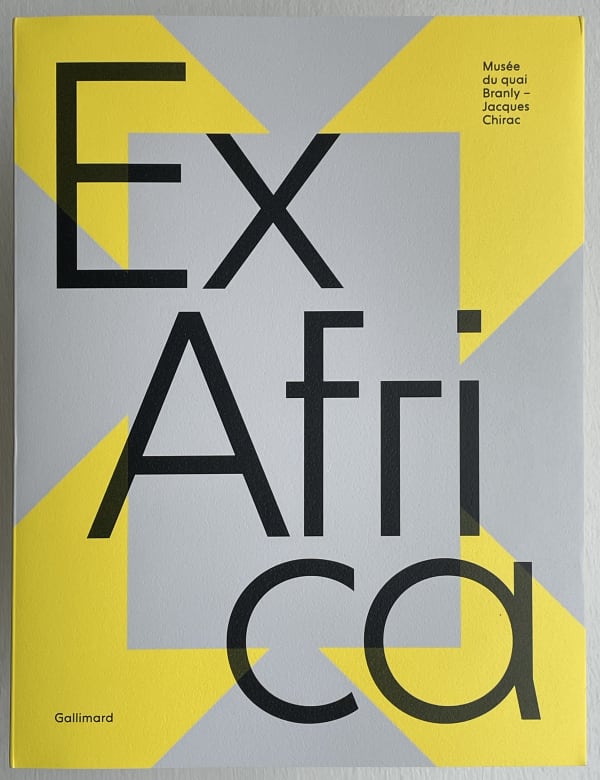
Ex Africa
Musèe du quai Branly - Jacques Chirac 2021 Read more
-
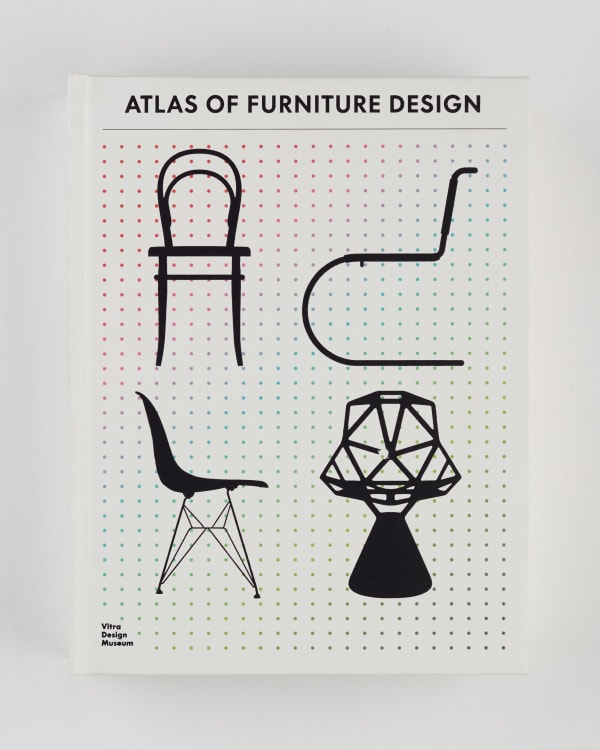
Atlas of Furniture Design
Vitra Design Museum 2019 Read more -

Kubatana: An Exhibition With Contemporary African Artists
Vestfossen, Kunstlaboratorium, Oslo, Norway 2019 Read more -
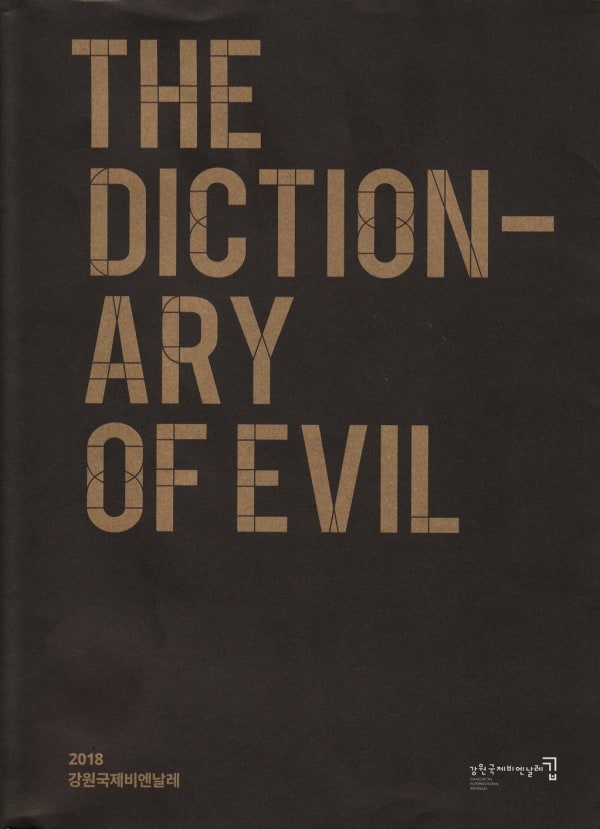
The Dictionary of Evil
Gangwon International Biennale, South Korea 2018 Read more -

The White Hunter
FM Centre for Contemporary Art, Milan 2017 Read more
-
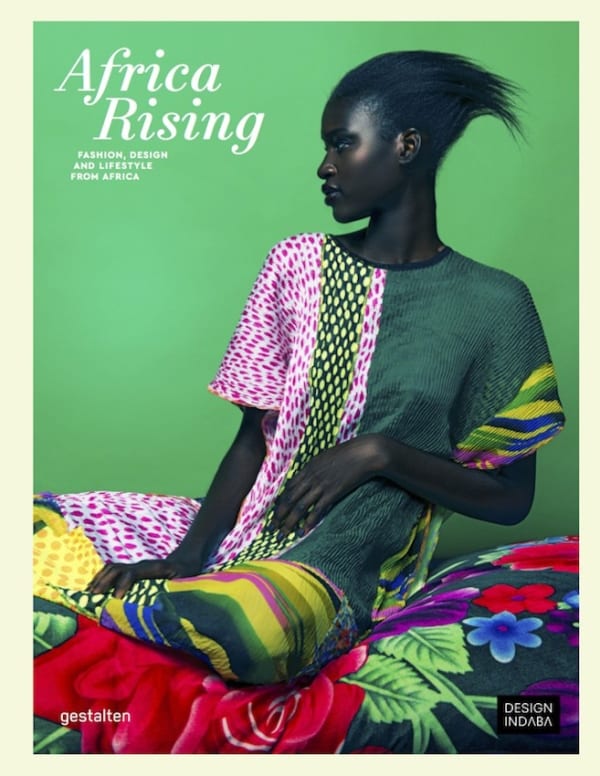
Africa Rising
Gestalten 2016 Read more -
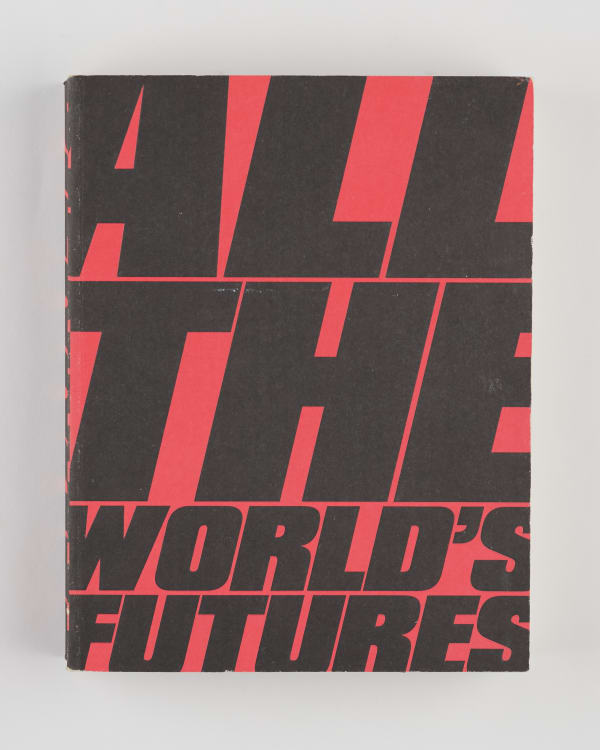
All the World’s Futures, curated by Okwui Enwezor
56th International Venice Biennale Art Exhibition 2015 Read more -
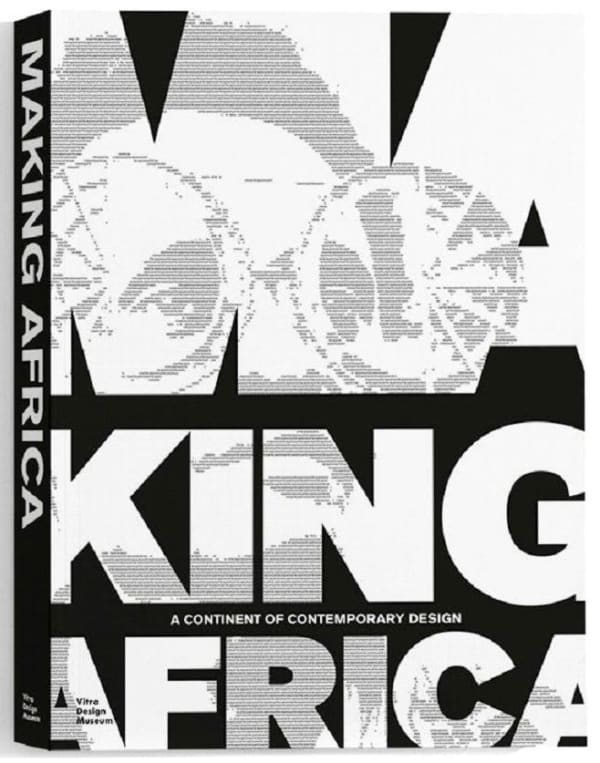
Making Africa: A Continent of Contemporary Design
Vitra Design Museum, Germany 2015 Read more -

Africa Now: Political Patterns
Seoul Museum of Art, South Korea 2015 Read more
-

KINGS AND QUEENS OF AFRICA: FORMS AND FIGURES OF POWER
Goncalo Mabunda and Léonce Raphaël Agbodjelou feature in exhibition at Louvre Abu Dhabi January 28, 2025For the first time in the UAE and the region, a new exhibition, Kings and Queens of Africa: Forms and Figures of Power, in collaboration...Read more -

Narrative Wisdom and African Arts at the Saint Louis Art Museum
Goncalo Mabunda included in exhibition of historical and contemporary African arts October 19, 2024Narrative Wisdom and African Arts explores how historical and contemporary African arts make visible narratives rooted in collective and individual memory and knowledge. The exhibition...Read more -

FAD Magazine
Paul's Gallery of the Week: Larkin Durey May 17, 2024If the name is unfamiliar, that’s because the Jack Bell Galler y, which ran 2010-24, has just been relaunched under the direction and ownership of...Read more -

Chazen Museum of Art, University of Wisconsin, USA
Featuring Ajarb Bernard Ategwa and Gonçalo Mabunda, showing from 5 September - 10 December 2023 June 22, 2023We are happy to announce 'Insistent Presence: Contemporary African Art from the Chazen Collection', a group exhibition which includes works by Ajarb Beranrd Ategwa and...Read more
-

Centraal Museum, Utrecht, Netherlands
Upcoming group exhibition entitled 'Statement Chairs', including work by Goncalo Mabunda, 5 Feb - 1 May, 2022. December 13, 2021 Read more -

Chazen Museum of Art, University of Wisconsin-Madison, USA
New acquisition of work by Goncalo Mabunda March 29, 2021When the Chazen Museum of Art opened in the fall of 1970 as the Elvehjem Art Center, the collection of 1,600 paintings and works on...Read more -

58th International Art Exhibition La Biennale di Venezia
Congratulations to Goncalo Mabunda for his participation in 'The Past, The Present and The In Between', National Pavilion of Mozambique, 11 May - 24 November 2019 April 17, 2019“The Past, The Present and The In Between” curated by Lidija Kostic Khachatourian and represented by Gonçalo Mabunda, Mauro Pinto and Filipe Branquinho, is showing...Read more -

Blouin Modern Painters
Goncalo Mabunda: Top Ten African Artists to Watch, February 2019 February 20, 2019Read more
-

Vestfossen Kunstlaboratorium, Oslo, Norway
'Kubatana', survey exhibition of contemporary African art including works by Aboudia, Armand Boua and Goncalo Mabunda. Curated by Kristin Hjellegjerde, show runs 4 May - 22 September 2019. January 30, 2019Read more -

Blanton Museum of Art, Austin, Texas
Touring group exhibition entitled 'Making Africa', including work by Goncalo Mabunda & Leonce Raphael Agbodjelou, 14 October 2018 – 6 January 2019. February 26, 2018Read more -

Minneapolis Institute of Art, USA
New acquisition of work by Goncalo Mabunda. February 26, 2018Read more -

Gangwon International Biennale, South Korea
Group exhibition entitled 'The Dictionary of Evil', including works by Goncalo Mabunda, 3 February - 18 March 2018. January 16, 2018Read more
-

Albuquerque Museum, New Mexico
Touring group exhibition entitled 'Making Africa', including work by Goncalo Mabunda & Leonce Raphael Agbodjelou, 3 February - 6 May 2018. September 8, 2017Read more -

Financial Times
'The Hero of a New Generation', Maya Jaggi, 24 June 2017 June 24, 2017Read more -

Royal Academy of Arts, London
Group exhibition including works by Aboudia & Goncalo Mabunda, 13 June - 20 August 2017. May 30, 2017Read more -

Institut fondamental d’Afrique noire, Dakar, Senegal
Group show entitled 'Lumieres d'Afriques', including work by Goncalo Mabunda, through to 20 February 2017. February 7, 2017Read more
-

High Museum of Art, Atlanta, USA
Group exhibition entitled 'Making Africa - A Continent of Contemporary Design', including work by Leonce Raphael Agbodjelou & Gonçalo Mabunda, 15 October 2017 - 7 January 2018. February 7, 2017Read more -

Kunsthal Rotterdam, Netherlands
Group exhibition entitled 'Making Africa: Continent of Contemporary Design', including work by Leonce Raphael Agbodjelou & Gonçalo Mabunda, through to 15 January 2017. January 12, 2017Read more -

Centre de Cultura Contemporania de Barcelona, Spain
Group show entitled 'Making Africa: A Continent of Contemporary Design', runs through to 28 August 2016. Includes work by Leonce Raphael Agbodjelou & Gonçalo Mabunda. April 22, 2016Making Africa CCCB Amelie Klein Okwui Enwezor Leonce Raphael Agbodjelou Goncalo Mabunda Vincent MicheaRead more -

Museum Angewandte Kunst, Germany
Group show entitled 'Unter Waffen. Fire and Forget 2', including work by Goncalo Mabunda, 9 September 2016 to 8 January 2017. April 20, 2016There are weapons everywhere: they exert an ambivalent fascination because they embody power, violence and superiority while also reminding us of pain and death. Whether...Read more
-

56th Venice Biennale, Italy
'All the World's Futures', curated by Okwui Enwezor, including work by Lavar Munroe & Goncalo Mabunda. Group exhibition runs 9 May - 22 November 2015. March 9, 2015Read more -

Guggenheim Bilbao, Spain & Vitra Museum, Germany
Touring group exhibition entitled 'Making Africa; A Continent of Contemporary Design', including work by Leonce Raphael Agbodjelou & Gonçalo Mabunda, 14 March 2015 through to2016. December 12, 2014From March 2015, a major exhibition by the Vitra Design Museum sheds new light on contemporary African design. Showcasing the work of over 120 artists...Read more -

Seoul Museum of Art, Korea
Group exhibition entitled 'Africa Now: Political Patterns', including works by Goncalo Mabunda, 16 December 2014 - 15 February 2015. December 12, 2014 Read more -

ArtReview
Butcheca and Goncalo Mabunda, Marie Darrieussecq, 1 December 2014 December 1, 2014Read more
-

Brooklyn Museum, USA
Group exhibition entitled 'Double Take: African Innovations', long-term installation, East Gallery / 1st Floor. October 1, 2014Kevin Dumouchelle Arts of Africa and the Pacific Islands Goncalo MabundaRead more -

Art + Auction Magazine
'New Light on Africa', Scott Reyburn, 1 October 2013 October 1, 2013Read more -

Herbert Art Gallery & Museum, UK
Group exhibition entitled 'Caught in the Crossfire', including work by Goncalo Mabunda, until 7 July 2013. June 18, 2013Herbert Art Gallery & Museum, Coventry, UKRead more -

Herbert Art Gallery & Museum, UK
New acquisition of work by Goncalo Mabunda. June 18, 2013Herbert Art Gallery & Museum, Coventry, UKRead more
-

Timeout
'2013 The Ones to Watch', Ossian Ward, 8 January 2013 January 8, 2013Read more -

Ocula
Conversations Q&A: Jack Bell, 5 December 2012 December 5, 2012Read more -

The Art Newspaper
'In the Frame', Gareth Harris, 1 March 2012 March 1, 2012Read more -

Museum of Art and Design, New York, USA
Group exhibition entitled 'The Global Africa Project', including work by Goncalo Mabunda. November 17, 2010Read more
-
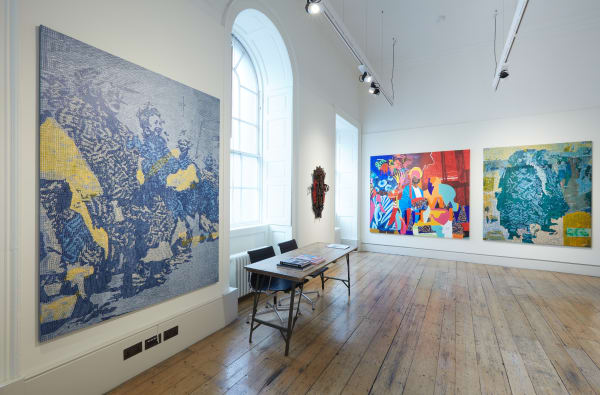
1-54 Contemporary African Art Fair, London
13 - 16 Oct 2022Jack Bell Gallery is pleased to present new works by Ajarb Bernard Ategwa, Gonçalo Mabunda, Lavar Munroe, Franco Ndiba and Manel Ndoye. VIP Preview: 13...Read more -
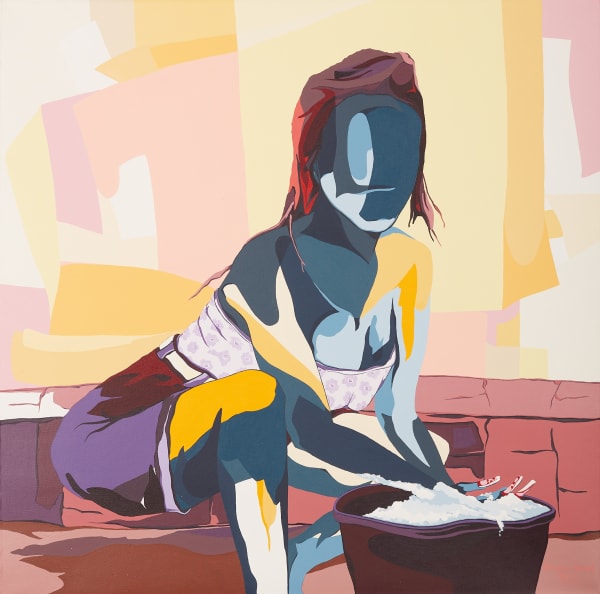
1:54 Contemporary African Art Fair, London
14 - 17 Oct 2021We are pleased to present new works by Aboudia, Ajarb Bernard Ategwa, Goncalo Mabunda, Franco Ndiba, Jean David Nkot and Marc Padeu.Read more -
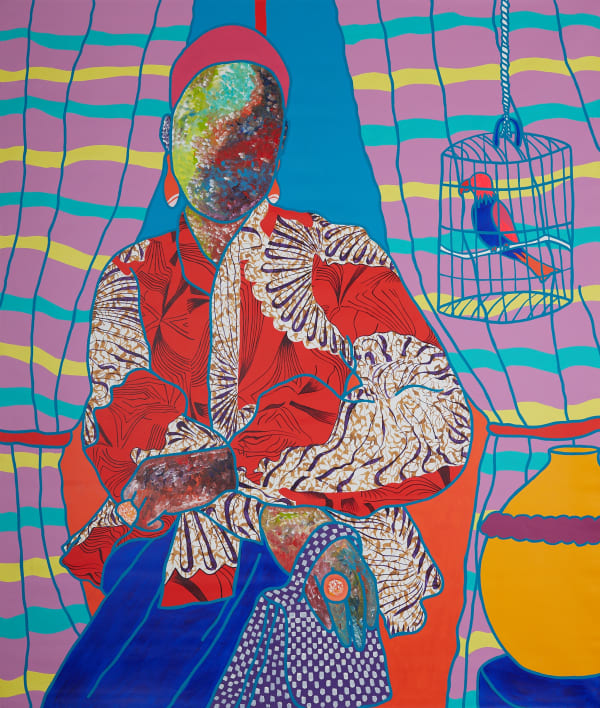
1:54 Contemporary African Art Fair, New York
Online Show 17 - 23 May 2021Jack Bell Gallery is pleased to present a works by: Aboudia Ajarb Bernard Ategwa Armand Boua Goncalo Mabunda Jean David Nkot Marc PadeuRead more -
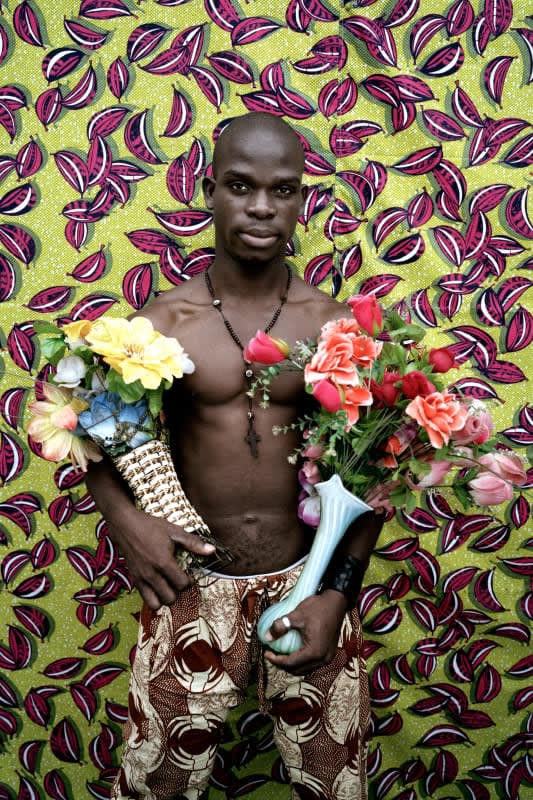
1:54 Contemporary African Art Fair, London
8 - 10 Oct 2020Jack Bell Gallery is pleased to present a group exhibition of new works by Aboudia, Leonce Raphael Agbodjelou, Ajarb Bernard Ategwa, Armand Boua, Gonçalo Mabunda,...Read more



